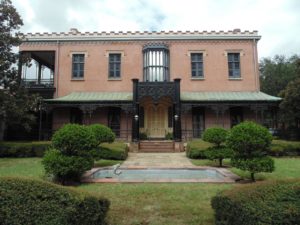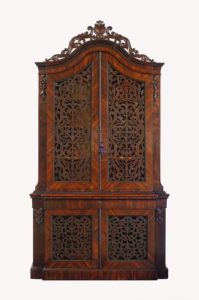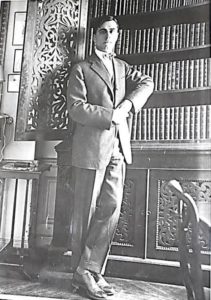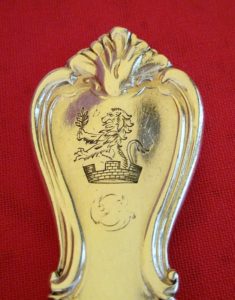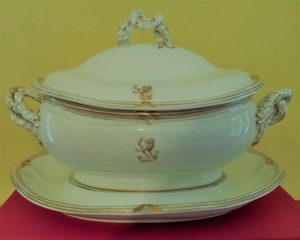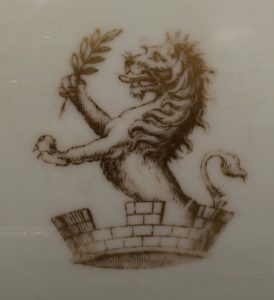Savannah’s Green-Meldrim House Acquires Important Family Collection
By TANIA JUNE SAMMONS
The Trust opened the spring symposium with an elegant reception at the Green-Meldrim House on Madison Square. The mid-19th-century Gothic Revival dwelling is the parish house for the adjacent St. John’s Church but first served as the private home of cotton merchant and English immigrant Charles Green, his wife, Lucy, and an extensive household consisting of seven children, nine enslaved servants, and one Irish-born female servant.
Designed by New York-based architect John Norris, whose work was influenced by the renowned A. J. Downing and A. J. Davis, the house features wonderful architectural details. The oriel windows, spacious rooms, and a sweeping circular staircase topped with an impressive domed skylight once lit at night by 98 gas jets are noteworthy. A detailed ledger kept by Norris was recently returned to the house, along with over 100 other family furnishings and archival materials, documents the architect’s involvement from 1850–1861. This important and richly detailed manuscript includes the names of carpenters, laborers, and suppliers, and will serve as an essential resource for architectural historians and others interested in American mid-19th-century building arts.
During the Civil War, Union General William Tecumseh Sherman used the Green House as his private quarters while occupying the city in late 1864 and early 1865. On January 12, 1865, a historic meeting between Sherman, Federal officials, and 20 black community leaders was held on site, leading to Special Field Order #15, a directive that distributed confiscated land to freemen along the coast in South Carolina, Georgia, and northern Florida. Some of the aforementioned recently returned objects were present during this historic moment.
The furnishings traveled to Paris in 1892 after Green’s son Edward sold the house to Judge Peter Meldrim, whose descendants then sold the house to St. John’s Church in 1943. Edward, the European agent for the Southern Cotton Oil Company, and his wife, Mary, missed their friends and family in Savannah, and their furnishings provided them with solace. Their affection for their belongings extended to their seven children, including the three born abroad.
The Green’s son Julien was a famous writer who became the first American member of the French Academy. Thus, while on sabbatical in France, these objects hosted Julien’s distinguished friends and associates, including Gertrude Stein, Marie Laurencin, André Gide, Jean Cocteau, and even the future Pope John XXIII. Julien was especially fond of his family heirlooms. He wrote of them in Restless Youth, Autobiography, Volume IV (1922–29): “I recognized myself in these furnishings which I have always tried to preserve in the family, as a kind of instinctive protection against whatever it may be: the outer world, society, events…all those things which threaten each one of us.”
The Trust’s symposium participants had the pleasure of being the first public audience to view a selection of the Green family holdings in Coming Home: The Green Collection Inaugural Exhibition, which remains on view through October. Acquired from Julien Green’s son, the collection will be integrated into the Green-Meldrim House over the next few years.
The Green’s furnishings were primarily purchased from sources in the Northeastern United States and England. For example, several pieces of furniture have New York origins, including a large, elegant bookcase attributed to the cabinetmaker Alexander Roux, and seating furniture made by Gustave Herter. Norris, the architect, likely served as the Greens’ conduit to the city’s leading craftsmen.
The Green’s ceramic service came from a set that originally included 124 pieces and was listed as the “Gold and white Dinner set (crest)” in the 1881 inventory compiled after Charles Green’s death. The 49 pieces now at the Green-Meldrim House include 19th-century examples made by Davenport in Staffordshire and Doulton in Burslem supplemented by 32 pieces (and 7 molds) produced at the Atelier de Ségriès in France in 1984. Each piece depicts the Green family crest of a rampant lion. The crest was likely taken from the coat of arms used by the Greens in England and was applied to many family objects, including china, silver, and embroidered upholstery.
The Green family’s silver collection includes sterling, coin, and plated examples and was sourced from England and the Northeast. The oldest pieces in the collection, flatware featuring the family crest and the initial “G,” are the most visually interesting examples in the collection, and would have made quite a presentation on the family’s table and sideboard alongside the white and gold ceramic service. These unattributed pieces show Charles Green’s interest in showcasing his family heritage at formal dinners and other social events.
The return of these carefully preserved family materials to the Green-Meldrim House signifies one of Savannah’s most important historical developments in the recent past. Collectively, the assemblage of objects and manuscripts—the Norris ledger, furniture, ceramics, silver, family photographs, and other archival materials—tell a local, national, and international story that enrich our shared understanding of the past and elevates the Green-Meldrim House to one of the most well-documented mid-19th-century dwellings in the country.
By TANIA JUNE SAMMONS
The Trust opened the spring symposium with an elegant reception at the Green-Meldrim House on Madison Square. The mid-19th-century Gothic Revival dwelling is the parish house for the adjacent St. John’s Church but first served as the private home of cotton merchant and English immigrant Charles Green, his wife, Lucy, and an extensive household consisting of seven children, nine enslaved servants, and one Irish-born female servant.
Designed by New York-based architect John Norris, whose work was influenced by the renowned A. J. Downing and A. J. Davis, the house features wonderful architectural details. The oriel windows, spacious rooms, and a sweeping circular staircase topped with an impressive domed skylight once lit at night by 98 gas jets are noteworthy. A detailed ledger kept by Norris was recently returned to the house, along with over 100 other family furnishings and archival materials, documents the architect’s involvement from 1850–1861. This important and richly detailed manuscript includes the names of carpenters, laborers, and suppliers, and will serve as an essential resource for architectural historians and others interested in American mid-19th-century building arts.
During the Civil War, Union General William Tecumseh Sherman used the Green House as his private quarters while occupying the city in late 1864 and early 1865. On January 12, 1865, a historic meeting between Sherman, Federal officials, and 20 black community leaders was held on site, leading to Special Field Order #15, a directive that distributed confiscated land to freemen along the coast in South Carolina, Georgia, and northern Florida. Some of the aforementioned recently returned objects were present during this historic moment.
The furnishings traveled to Paris in 1892 after Green’s son Edward sold the house to Judge Peter Meldrim, whose descendants then sold the house to St. John’s Church in 1943. Edward, the European agent for the Southern Cotton Oil Company, and his wife, Mary, missed their friends and family in Savannah, and their furnishings provided them with solace. Their affection for their belongings extended to their seven children, including the three born abroad.
The Green’s son Julien was a famous writer who became the first American member of the French Academy. Thus, while on sabbatical in France, these objects hosted Julien’s distinguished friends and associates, including Gertrude Stein, Marie Laurencin, André Gide, Jean Cocteau, and even the future Pope John XXIII. Julien was especially fond of his family heirlooms. He wrote of them in Restless Youth, Autobiography, Volume IV (1922–29): “I recognized myself in these furnishings which I have always tried to preserve in the family, as a kind of instinctive protection against whatever it may be: the outer world, society, events…all those things which threaten each one of us.”
The Trust’s symposium participants had the pleasure of being the first public audience to view a selection of the Green family holdings in Coming Home: The Green Collection Inaugural Exhibition, which remains on view through October. Acquired from Julien Green’s son, the collection will be integrated into the Green-Meldrim House over the next few years.
The Green’s furnishings were primarily purchased from sources in the Northeastern United States and England. For example, several pieces of furniture have New York origins, including a large, elegant bookcase attributed to the cabinetmaker Alexander Roux, and seating furniture made by Gustave Herter. Norris, the architect, likely served as the Greens’ conduit to the city’s leading craftsmen.
The Green’s ceramic service came from a set that originally included 124 pieces and was listed as the “Gold and white Dinner set (crest)” in the 1881 inventory compiled after Charles Green’s death. The 49 pieces now at the Green-Meldrim House include 19th-century examples made by Davenport in Staffordshire and Doulton in Burslem supplemented by 32 pieces (and 7 molds) produced at the Atelier de Ségriès in France in 1984. Each piece depicts the Green family crest of a rampant lion. The crest was likely taken from the coat of arms used by the Greens in England and was applied to many family objects, including china, silver, and embroidered upholstery.
The Green family’s silver collection includes sterling, coin, and plated examples and was sourced from England and the Northeast. The oldest pieces in the collection, flatware featuring the family crest and the initial “G,” are the most visually interesting examples in the collection, and would have made quite a presentation on the family’s table and sideboard alongside the white and gold ceramic service. These unattributed pieces show Charles Green’s interest in showcasing his family heritage at formal dinners and other social events.
The return of these carefully preserved family materials to the Green-Meldrim House signifies one of Savannah’s most important historical developments in the recent past. Collectively, the assemblage of objects and manuscripts—the Norris ledger, furniture, ceramics, silver, family photographs, and other archival materials—tell a local, national, and international story that enrich our shared understanding of the past and elevates the Green-Meldrim House to one of the most well-documented mid-19th-century dwellings in the country.

